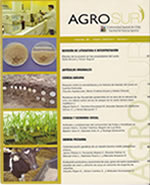Finishing strategies for cull cows under grass-based production systems in Uruguay
Main Article Content
Abstract
This study aimed to evaluate the effect of different levels of forage allowance (FA) of Avena bizantina cv. INIA Halley and Rice Bran (RB) supplementation on animal performance and carcass quality (in vivo) of cull cows in Uruguay. The experiment was carried out for 130 days (May-September 2013). Forty Hereford cows with a body weight (BW) of 480 ± 48.5 kg were allocated to four treatments (T) combining FA (2 and 4% BW) and RB supplementation rate (0.8 and 1.6% BW) as follows: T1 (FA2), T2 (FA4), T3 (FA2+RB0.8) and T4 (FA2+RB1.6). There were no differences (p > 0.05) between treatments in neither average pre-grazing forage mass nor forage height. Average post-grazing forage mass (p < 0.05) and height (p < 0.01) was greater for T2, while T1 presented the lowest values. The final BW (p < 0.05) and average daily gain (p < 0.01) was lower in T1 compared to the other treatments. Total BW production per hectare was similar between T3 and T4 and greater (p < 0.01) than T1 and T2 (similar between them). Supplemental feed efficiency was greater in T3 than in T4 (p < 0.01). The subcutaneous fat level was lowest in T2 when compared with the rest of the treatments, which were similar between them (p < 0.01). The strategic use of annual winter forage crops and/or strategic supplementation on pasture-based systems improved the animal performance and carcass quality of Hereford cull cows.

